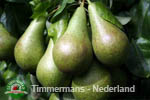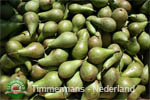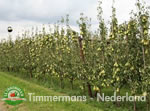 The exact origin of the pear is not known. It is often thought that the pear originates from the area between the Black Sea and the Caspian Sea, but some place it further east, south of the Ural Mountains or even towards Central Asia. From the wild pears, edible varieties of pears have been developed through breeding. Until the 16th century pears were only suitable for cooking, the so-called cooking pears, so pears had to be cooked before they could be eaten. From the 16th century onwards the first eaters were cultivated in France and Italy. These are varieties that can be eaten without any need for cooking or processing.
The exact origin of the pear is not known. It is often thought that the pear originates from the area between the Black Sea and the Caspian Sea, but some place it further east, south of the Ural Mountains or even towards Central Asia. From the wild pears, edible varieties of pears have been developed through breeding. Until the 16th century pears were only suitable for cooking, the so-called cooking pears, so pears had to be cooked before they could be eaten. From the 16th century onwards the first eaters were cultivated in France and Italy. These are varieties that can be eaten without any need for cooking or processing.
 Since the first eating pears were introduced several thousand different varieties have been brought to market. The distinguishing aspect of pears is that the difference in flavours between the different varieties is much greater than it is in other fruits such as apples. Flavours range from sweet to sour (sharp), the flesh from hard to soft as butter, from smooth to granular and from faintly aromatic to very aromatic. So there is something to suit everybody. Even the names of the varieties prickle the imagination much more than the names of many apples.
Since the first eating pears were introduced several thousand different varieties have been brought to market. The distinguishing aspect of pears is that the difference in flavours between the different varieties is much greater than it is in other fruits such as apples. Flavours range from sweet to sour (sharp), the flesh from hard to soft as butter, from smooth to granular and from faintly aromatic to very aromatic. So there is something to suit everybody. Even the names of the varieties prickle the imagination much more than the names of many apples.
 The well-known varieties of pear include Doyenné du Comice, Beurré Hardy, Beurré Alexandre Lucas, Comtesse de Paris, Charneux, Bonne Louise d'Avranches and Triomphe de Vienne./p>
The well-known varieties of pear include Doyenné du Comice, Beurré Hardy, Beurré Alexandre Lucas, Comtesse de Paris, Charneux, Bonne Louise d'Avranches and Triomphe de Vienne./p>
In other words, magnificent names for this king of fruit. All these varieties were cultivated in the cradle of edible pear cultivation, the mainland of Western Europe. But other well-known varieties are found outside this area, such as Packham's Triumph from Australia, Bartlett, or Williams Bon Chretien from England and not to forget the Conference, which also originates from England.
 Conference is by far the most widely grown pear in north-west Europe. The variety was found in 1884 as an open pollinated seedling, from a Leon Leclerc de Laval. This variety is cultivated by Thomas Rivers, from Sawbridgeworth in England, and was subsequently named 'Conference' in 1895 after the 'British National Pear Conference' where it was first exhibited. It was not long before this variety occupied a major position within European pear cultivation. This was due not only to its good flavour characteristics but also to its excellent storage properties. During the last few decades the quality of Conference has been further improved following changes to cultivation techniques, so that it has now become the undisputable number one in pear cultivation in the Netherlands and Belgium.
Conference is by far the most widely grown pear in north-west Europe. The variety was found in 1884 as an open pollinated seedling, from a Leon Leclerc de Laval. This variety is cultivated by Thomas Rivers, from Sawbridgeworth in England, and was subsequently named 'Conference' in 1895 after the 'British National Pear Conference' where it was first exhibited. It was not long before this variety occupied a major position within European pear cultivation. This was due not only to its good flavour characteristics but also to its excellent storage properties. During the last few decades the quality of Conference has been further improved following changes to cultivation techniques, so that it has now become the undisputable number one in pear cultivation in the Netherlands and Belgium.
Source Timmermans - The Netherlands ( www.timfruit.nl )